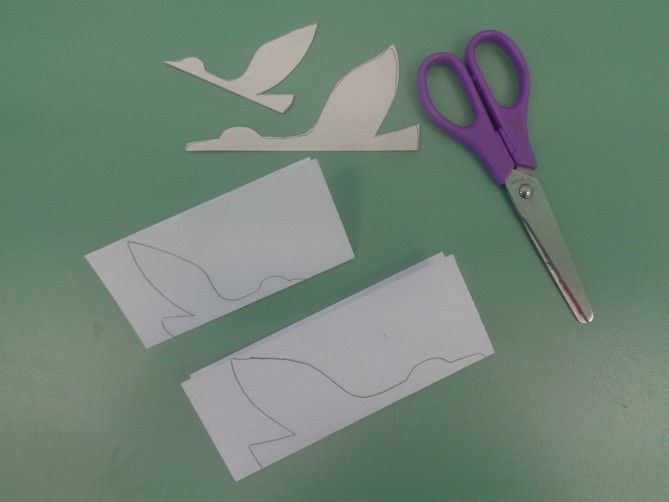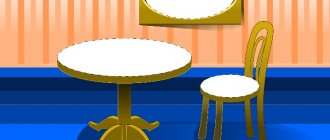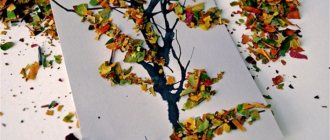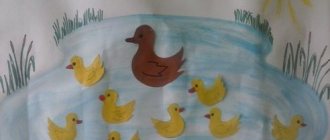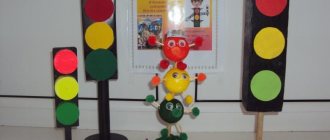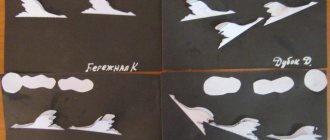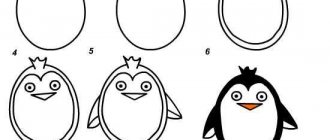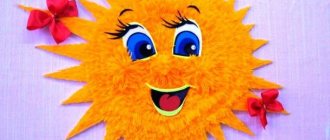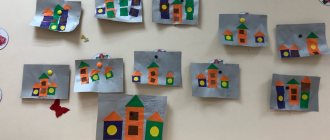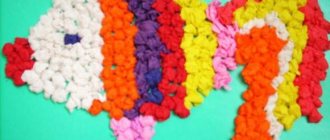First option
You will need:
- base sheet
- brushes and watercolor
- cotton pads
- glue
- plasticine
Sequencing:
- Prepare the main working material. Paint with gouache and mark the barnyard where the chicks supposedly walk. You can just take colored cardboard.
- Dye cotton pads yellow. Cut them in half or trim rounds to give the body the desired shape.
- Glue the blanks on the base plane.
- Complete your creation with plasticine parts. You can create a beak, eyes and paws from this material or complement the composition of the work with plant details.
We provide several variations of the design of compositions on this theme.
Feather birds
Feathers also make great bird crafts! For example, a craft made from a pine cone, paper and feathers will be an excellent interior decoration.
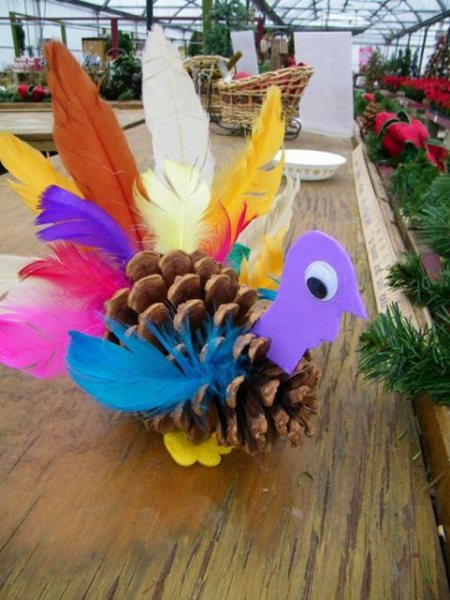
In order to make such a craft, we will need:
- Cone;
- Multi-colored feathers;
- Thick paper for making the head and paws;
- Glue gun.
Before starting work, the pine cone must be dried in the oven for 20-30 minutes. This will get rid of excess moisture and insects inside.
The dried cone can be painted with paints, or you can leave the natural color and texture. We glue the cut out parts of the paws to the bottom of the cone, and also glue the head to the pointed end of the cone. You can glue toy eyes to your head, or you can draw them yourself. Now all that remains is to attach the feathers. We carefully place them on glue. The more feathers there are, the more magnificent the bird’s “hair” will be.
Related article: Modular origami. Japanese magazine with master classes
There is also another way to make a bird from feathers.
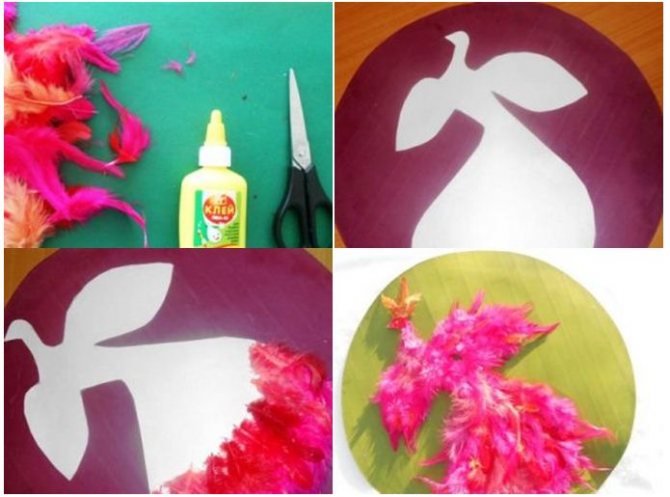
We will need:
- 2 sheets of cardboard (white and any color);
- Glue;
- Scissors;
- Feathers.
Cut out the silhouette of a bird from white cardboard. In our case, this is the firebird. The silhouette, starting from the tail, must be covered with feathers. You can stick them on top of each other. Then we glue the cutout with feathers to colored cardboard. The painting can be framed and will be a great decoration for any room in your home!
Second way
A simplified way to create chickens or geese will be possible even for the smallest.
Sequencing:
- Draw or print a picture of a bird.
- Paint the comb, paws, eyes, etc.
- Take regular cotton wool and tear it into small pieces.
- Using craft glue, attach the white lumps in the places where the feathers should be.
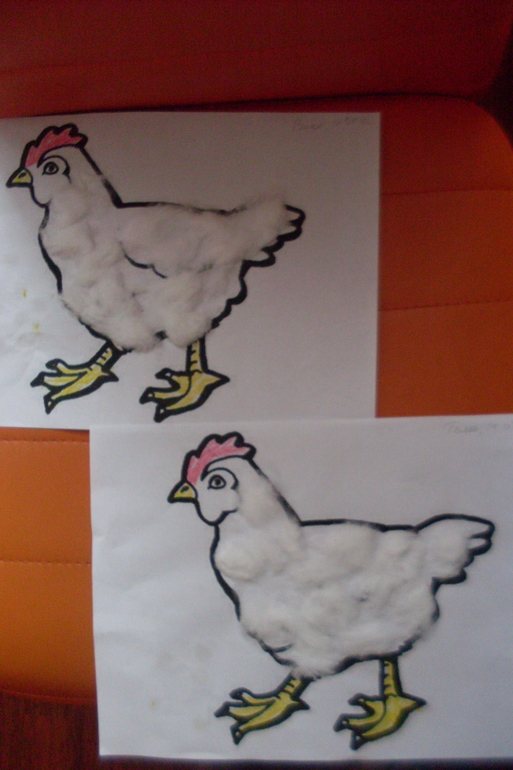
Third option
A more complex method for older children.
Sequencing:
Create an original background on a landscape sheet that will match the theme of the work. In extreme cases, the sky and grass will suffice.
Mark with a pencil where the rest of the elements will be located. Cut out parts of the house from colored sheets and glue them to the base, which should already be dry.
Download a black and white drawing of a chicken and a rooster from the Internet. If you know how, you can draw it by hand on a white sheet. Cut out the silhouette.
Prepare colored elements that will correspond to the sizes and shapes of body parts: wings, comb, body, tail feathers, etc.
Glue the blanks and decorate the top with colored paper pieces.

All this work can be done collectively, entrusting the child with the responsible work of gluing the parts in the right places.
Firebird
A fairy-tale character who looks as fantasy suggests. An ideal composition for beginners.
Crafts addition
So that the craft does not seem empty, you need to create the right environment for the birds. For example, for a chicken craft, you can create scattered food around it.
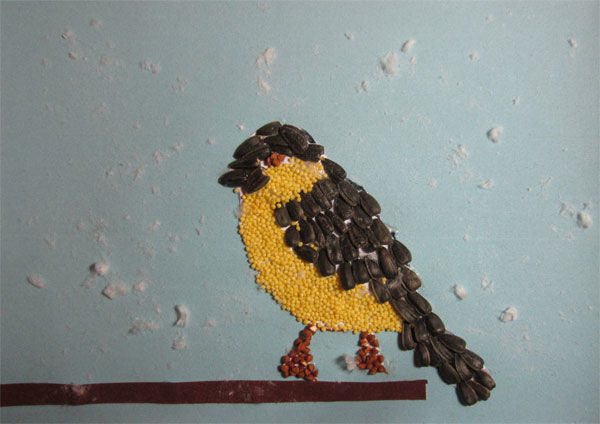
To imitate it, real seeds glued to the base of the craft are perfect. However, gluing small parts is a very painstaking job that requires maximum care.
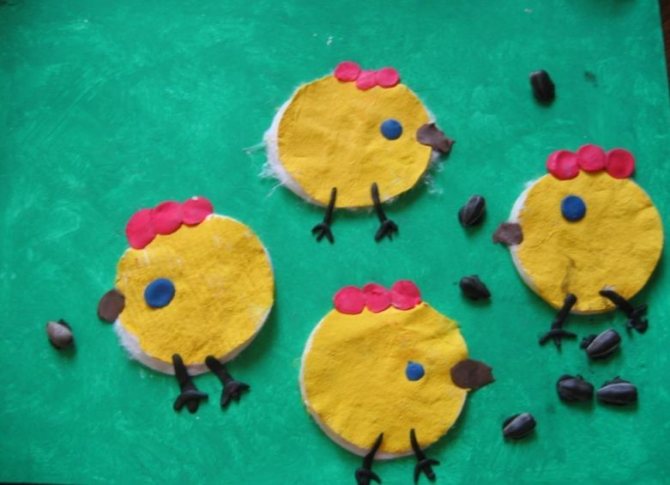
In addition, working with small parts is not recommended for children under 3 years of age without parental or teacher supervision.

You can also create a small house, make grass, sun and clouds. You can add virtually anything, the child must imagine the environment himself, there is no need to interfere with his creative impulses.

It only makes sense to guide him, telling him how to correctly make this or that detail for his craft.
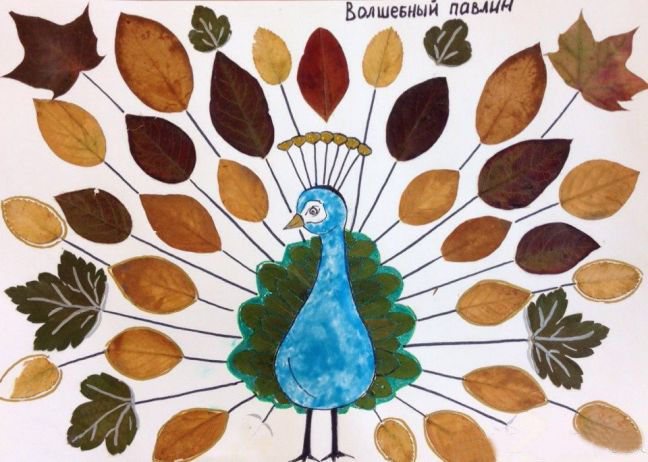
Creating a house
The simplest thing would be to make one or more small bird houses in the background. To do this, you first need to cut out a square or rectangle that will serve as the base.

Next, you need to make a roof; for this, a triangle is cut out in size suitable for a square or rectangle. Its color may differ from the base, at the request of the child.
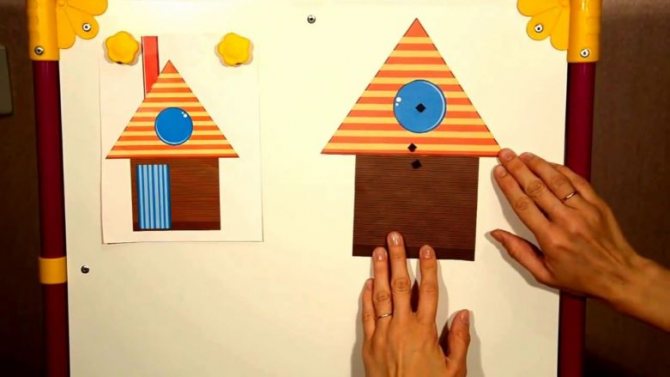
All this is glued to the base of the craft using a glue stick. Next, you need to make windows; for this, small squares are cut out of white or blue paper, which are then glued to the walls of the house.
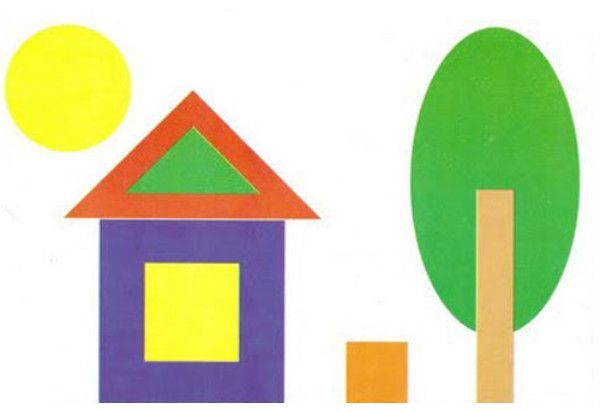
To make frames, you can draw classic crosses on top of the window blanks with a pencil or felt-tip pen. All that remains to be done is the chimney, an integral attribute of village houses.

For this purpose, you need to cut a small strip from the same paper from which the roof was cut. Next, you just need to glue it to the roof in any place where it will be most convenient.

The second method is mosaic
- Choose different colors, but similar tones. For example, different shades of red or orange.
- Cut into pieces close to square, rectangular, triangular shapes, but of different sizes.
- Glue them onto plain cardboard to create the desired image.
This is what a craft made using this method looks like.
Wild birds
This is a method of embodying the lifestyle of untamed winged creatures, as children see them. Most often, such compositions depict keys flying to the south, as well as caring mothers in a nest with babies or in search of food among the foliage of a tree.
A three-dimensional image will be able to convey all the beauty as much as possible.
Sequencing:
- The base must be solid. You can simply take a plain sheet of cardboard or paint it, adding elements that correspond to the character of the product (leaves, flowers, clouds, etc.)
- Fold white A4 in half and along the fold draw the shape of a bird from the side - head, elongated neck, raised wing, tail.
- Cut along the outline and glue on one side only.
- Create several of these birds, preferably of different sizes, so that they are not identical.
- After the glue has dried, “straighten the feathers” of the jamb - slightly twist the part of the wing that is not glued to the outside so that it puffs up. A few cuts symbolizing plumage will also not hurt.
In winter, it will be relevant to implement the idea of winged animals that do not fly to warmer climes. The birds at the feeder will remind you of caring for our little brothers. Bullfinches and tits can be easily recognized by the bright colors of their plumage, and your plans can be realized with the help of decorated cotton pads.
How to make notes for a lesson on application
The lesson on the applicative type of art creation includes three stages:
- introductory to familiarize yourself with the topic, appeal to the experience of children - up to 3 minutes;
- the main one for carrying out preparatory work, preparing materials and tools, completing tasks and physical education for 10–15 minutes;
- the final one for assessing children’s work and reflection - up to 3 minutes.
Table: Kasatkina M.V. lesson notes on appliqué (work in pairs) on the topic “Birds on a branch” (fragments)
| Stage | The essence |
| Introductory | The teacher holds a book in his hands and invites the children to come up (the children stand in a semicircle around the teacher). - Guys, there is a riddle about a bird hidden in this book, listen carefully, I’ll read about it to you now, try to guess who we are talking about? … > |
| <… The teacher puts a picture of a titmouse on the easel. — Guys, is the tit a migratory or wintering bird? Children give the answer and prove it. - Look at what a wonderful tit flew in and sat on a branch (shows a sample). | |
| Educator: - Guys, it’s easier for both animals and birds to overwinter when they are together, so let’s not leave our tit alone and place a whole flock with her. - Tell me what the bird has? Children name the components of the bird's body. | |
| Basic | The teacher displays a mnemonic table on the easel depicting the sequence of carving a bird. - Guys, there are geometric shapes of different colors and sizes on the tray, let's tell you what parts we will cut out the tit from (from a black square - the head, from a yellow rectangle - the body, from a black rectangle - the wing, small parts - the tail, the eye and beak are already ready, you will finish drawing the bird’s legs with a pencil). If necessary, the teacher shows ways of working. |
| - Before we start work, we will rest. Children stand in a circle. Finger gymnastics “Flock of Birds” is carried out. When naming birds, bend your fingers. Sing, sing along, ten birds are a flock. - This bird is a nightingale, this bird is a sparrow. This bird is an owl, a sleepy little head. This bird is a waxwing, this bird is a corncrake. This bird is a little gray feather. This one is a chaffinch, this one is a swift, this one is a cheerful siskin. Well, this is an evil eagle. Birds, birds, go home! (Clench your fingers into fists.) | |
| The teacher removes the sample. — Guys, you will again do the work in pairs, so help each other, consult. Don't forget that before gluing, you should first place the birds on a branch. And please be careful with scissors, and our magic helper table will remind you how to work with them. The teacher sets up a mnemonic table “Working with scissors.” | |
| - Now get to work. Children perform the appliqué in pairs, the teacher helps, controls the children, helps. | |
| Final | At the end of the work, the teacher offers to clean his workplace and places a sample on the easel. “Our titmouse won’t be sad now, bring your work and we’ll have a whole flock of titmice.” Children exhibit their works and admire them. |
| Quote via: https://nsportal.ru/detskiy-sad/applikatsiya-lepka/2017/02/17/moi-zanyatiya | |

At the end of the lesson, the teacher should thank the children for their work and praise the results of their creativity
Video: lesson on collective application on the topic “Migratory Birds” in the senior group
other methods
Tear-off - the picture is assembled from small multi-colored pieces. This technique trains perseverance because it takes much longer than the others. Additionally, fine motor skills are developed, since working with small elements is very painstaking.
Volumetric - the nest is often depicted on a paper plate or papier-mâché craft. The materials from which the product will be made can be very diverse: cotton wool, feathers, threads, dry grass, felt, paper, etc. It all depends on the child’s capabilities and imagination.
The combinations are countless. The miraculous embodiment is practiced not only in kindergartens, but also by art history professionals.
Chickens and geese
These poultry have abundant plumage, which also needs to be indicated on the applique. Depending on the age of the child, applique with these birds can be of different types.
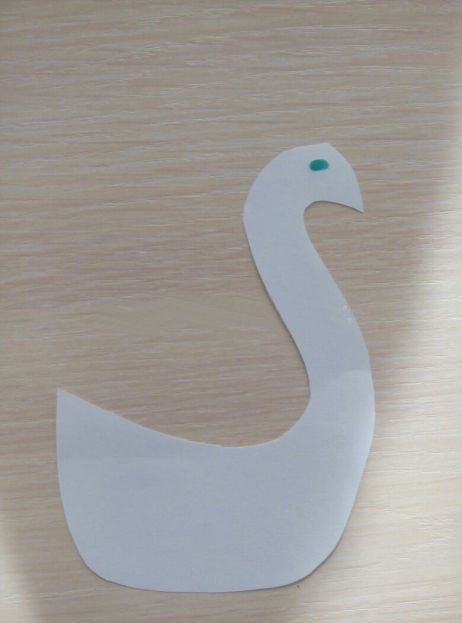
For the little ones, the same approach is used as when making chicken. As a final step, the child will need to place cotton wool on it, which will imitate plumage.
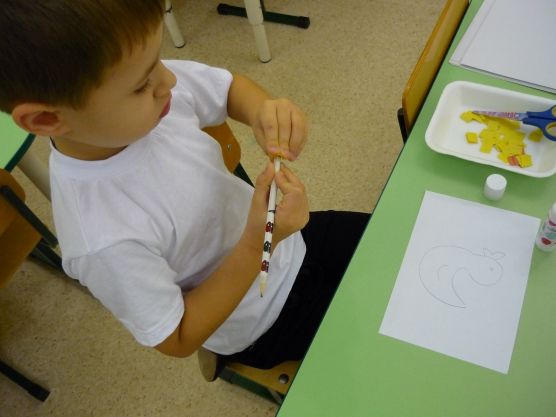
For older children, for example, for the second or third year of being in kindergarten, pre-prepared bird templates are used. They are printed on paper and given to children. And they, in turn, must correctly fill the template with cotton wool where it is needed.

The remaining parts should be colored with felt-tip pens, pencils or colored pens, whichever is more convenient for you.
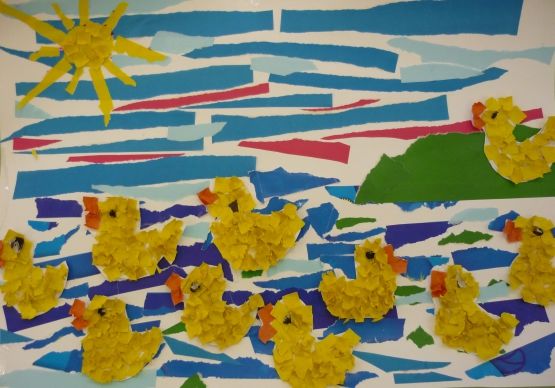
For this craft you will need:
- Glue stick
- Outline drawings of birds
- Paints, pencils, pens
- cotton wool
- Scissors
